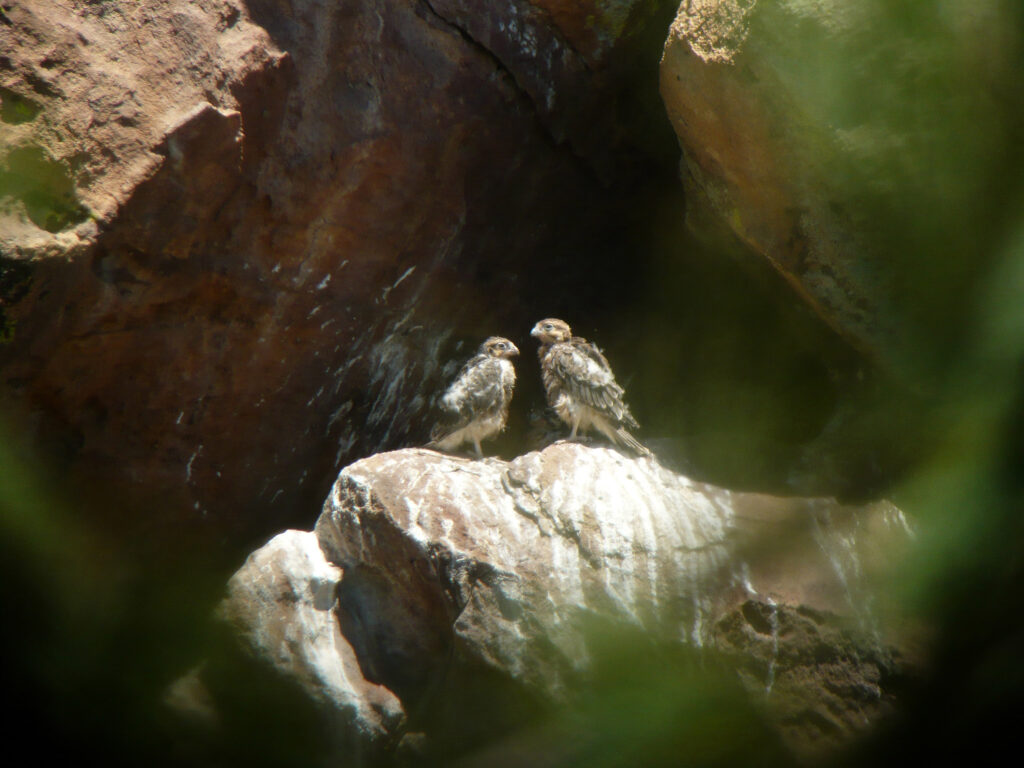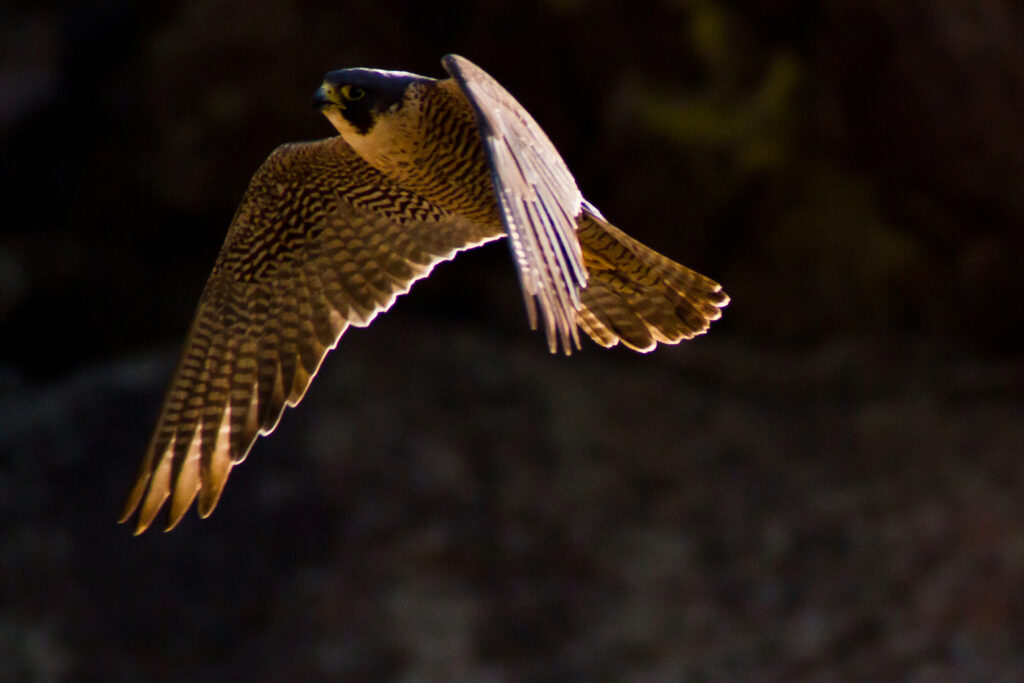Record number of falcons fledged in Boulder’s Flatirons last year

Saturday, Jan. 15, 2022
2021 was a dismal year for natural disasters, global health and American democracy. Amid the chaos and catastrophe, one group of Boulder residents was flourishing: five pairs of peregrine falcons nesting in the city’s iconic Flatirons.
Last year, they produced 11 fledglings — as baby birds are known once they are capable of flight — the most on record since the raptors returned to the rocky formations two decades ago.
The number was so remarkable that the city put it on a list of 2021 accomplishments in environmental sustainability, alongside such items as a 22% reduction in emissionsIn this context, the GHG that are released into the atmosphere from the burning of fossil fuels to g... and adoption of a brand-new climate action plan. Credit, in part, goes to a dedicated network of bird-watching volunteers and the buy-in of the local climbing community.
“I cannot overstate how successful this program have been,” said Rui Ferreira, president of Flatirons Climbing Council, a group that advocates for climbing access in Boulder open space. “We don’t know of any other land management in the federal or state level that have had this type of success.”
Raptor rebound
Peregrine falcons are among the ubiquitous of raptor species, present on every continent but Antartica and common even in large cities. They nest on cliffs (in urban environments, building ledges or bridges will do) and hunt other birds, diving at speeds of 200 miles per hour to stun or kill their prey.
Read: Denver used to build skyscraper nests for falcons. Why did they stop? CPR
Like many bird species, peregrine falcons were hard hit by widespread chemical use in mid-century America. While there are records of falcons dating back to the 1880s, according to OSMP wildlife ecologist Will Keeley, they disappeared from the Flatirons around 1960 and weren’t seen again for 30 years.
When they returned, Boulder was practiced in a key part of preservation: keeping nesting areas free from disturbance. The first raptor-related closure of a climbing area in Boulder (and possibly the U.S.) was Skunk Canyon in 1986, for a pair of golden eagles.
Keeping climbers off cliffs during nesting season is important, because human activity can spook the birds into abandoning attempts to propagate. According to a white paper from Access Fund, birds are particular sensitive while coupling, establishing a nest and incubating eggs.
Climbers are one of the few people positioned to access sensitive areas. As such, they’re also well placed to be part of the solution.
“Sometimes it’s climbers who bring nests to the attention of rangers,” Ferreira said. “That has happened multiple times in the past.”
Notifications are important, because that’s how rangers know which areas to close and how many birds are in the area. Typically, this information comes from the 40-50 volunteers who make up a robust raptor monitoring program, one of the oldest in the nation.
“The volunteers love what they do, and they keep coming back each year,” Keeley said. “It’s a program we don’t see a lot of attrition at.”
‘Part of the climbing schedule’
Raptor closures are lengthy, running from February (when peregrine falcons pair up) through July (after fledglings have left the nest for good). Nesting sites change year to year but are often located in popular climbing spots. Last year’s closures included the Third Flatiron, which “when it’s open, it’s just like an escalator,” Keeley said.
Despite some routes being inaccessible for half the year, Ferreira said local climbers have mostly adjusted.
“Everyone knows that closures happen on the 31st of January until the 31st of July,” he said. “You see people posting on various forums, ‘Hey the closures are coming up, get your climbs in,’ and posts anticipating the end of the closures.
“It has become part of the climbing schedule.”
Ferreira said the climbing community appreciates Boulder’s adaptive approach, wherein they close targeted areas rather than whole swaths of land and lift closures early when anticipated nests weren’t actually established.
“That’s unique” among government land owners, many of whom “go beyond what the science suggests,” Ferreira said. “If it was closure after closure with no evidence of an active nest, t
hat gets frustrating.”
Keeley is similarly grateful to the climbing community for doing its part, spreading the word about closures and self-policing rare violators. They also adapt to changing circumstances: Like last year, when a late spring snow caused two pairs of peregrine falcons to abandon their first nests and restart later in the season. That extended the closures by nearly two weeks in the summer on the Mickey Mouse Wall and Third Flatiron — time Keeley believes resulted in the higher-than-average number of baby birds.
“The birds needed 11 more days,” Keeley said. “The relationship we have with the climbing community when we do have a new closure pop up… they’re our partners in protecting this resource.”

More than cliff closures
While 2021 may have been a banner year, there’s no indication of an overall trend. Just two years ago was a record low in terms of fledglings, likely due to heavy spring snow.
Peregrine populations across North America seem steady, according to the Raptor Population Index, while the Audubon Society’s Christmas Bird Count reports a 3.5% annual increase. Keeley estimates there are about 200 nesting pairs of peregrine falcons in Colorado, from the Front Range to the western edge of the state.
Learn more about peregrine falcons in Colorado
Cliff closures aren’t the only factor in Boulder’s falcon surfeit. Keeley attributes the city’s vast open space acreage to the species’ success.
“The city is not only protecting prime nesting habitat, but also the foraging habitat around the city as open space grasslands,” he said. “Providing not only the nesting habitat but also the foraging habitat allows the birds to be comfortable not only nesting and rearing young, but also teaching their young to hunt. The adults will do a fly-by with something in their talons, and that will cause the fledgling to emit this begging call and then chase the adult. The adults will drop the prey, and the fledgling will catch it in mid-air.
“Just the sheer skill that these birds have, it is one of the coolest aerial displays that I’ve ever seen.”
The need to preserve open land was noted by CU’s Center for Sustainable Landscapes and Communities, in a study that found winter raptor sightings in Boulder County have declined over the past three decades. (Peregrine falcons were not among the tracked species.)
“Birds of prey are predators at the top of the food chain,” authors wrote, “and their presence serves as a barometer for ecological health.”
Ferreira tracks OSMP’s falcon fledglings each year, the numbers a tangible sign that climbers’ efforts are paying off.
“We are cognizant that what’s happening in the Flatirons is so unique in its success,” he said.
“It’s quite a wonderful thing.”
— Shay Castle, @shayshinecastle
Want more stories like this, delivered straight to your inbox? Click here to sign up for a weekly newsletter from Boulder Beat. Help make the Beat better. Was there a perspective we missed, or facts we didn’t consider? Email your thoughts to boulderbeatnews@gmail.com
Open Space Access Fun Boulder city of Boulder climbers climbing Endangered Species Act Flatirons Flatirons Climbing Council open space OSMP peregrine falcons raptor raptor monitoring volunteers

